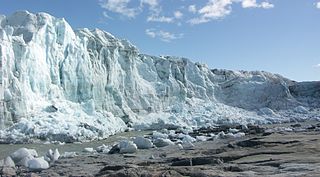Aurora Subglacial Basin is a large subglacial basin of Wilkes Land to the west of Dome Charlie and trending northwest toward the coast in the vicinity of Shackleton Ice Shelf. The basin was delineated by the SPRI-NSF-TUD airborne radio echo sounding program, 1967–79, and named after Aurora, the ship of the Australasian Antarctic Expedition, 1911–14, led by Douglas Mawson.

A structural basin is a large-scale structural formation of rock strata formed by tectonic warping of previously flat-lying strata. Structural basins are geological depressions, and are the inverse of domes. Some elongated structural basins are also known as synclines. Structural basins may also be sedimentary basins, which are aggregations of sediment that filled up a depression or accumulated in an area; however, many structural basins were formed by tectonic events long after the sedimentary layers were deposited.

Wilkes Land is a large district of land in eastern Antarctica, formally claimed by Australia as part of the Australian Antarctic Territory, though the validity of this claim has been placed for the period of the operation of the Antarctic Treaty, to which Australia is a signatory. It fronts on the southern Indian Ocean between Queen Mary Coast and Adelie Land, extending from Cape Hordern in 100°31' E to Pourquoi Pas Point, in 136°11' E. The region extends as a sector about 2600 km towards the South Pole, with an estimated land area of 2,600,000 km², mostly glaciated. It is further subdivided in the following coastal areas which can also be thought of as sectors extending to the South Pole:
- Knox Land: 100°31' E to 109°16' E
- Budd Land: 109°16' E to 115°33' E
- Sabrina Land: 115°33' E to 122°05' E
- Banzare Land: 122°05' E to 130°10' E
- Clarie Land: 130°10' E to 136°11' E

Shackleton Ice Shelf is an extensive ice shelf fronting the coast of East Antarctica for about 384 km, projecting seaward about 145 km in the western portion and 64 km in the east. It occupies an area of 33,820 km². It is part of Mawson Sea and separates the Queen Mary Coast to the west from the Knox Coast of Wilkes Land to the east. The existence of this ice shelf was first made known by the USEE under Charles Wilkes who mapped a portion of it from the Vincennes in February 1840. It was explored by the Australian Antarctic Expedition under Douglas Mawson (1911–14) who named it for Sir Ernest Shackleton. The extent of the ice shelf was mapped in greater detail in 1955, using aerial photography obtained by US Navy Operation Highjump, 1946-47. Further mapping by the Soviet Expedition of 1956 showed the portion eastward of Scott Glacier to be a part of this ice shelf.
The Aurora Subglacial Basin is largely grounded below sea level, making it susceptible to marine ice sheet instability. The Aurora Subglacial Basin is drained in part by Totten Glacier, which responds readily to melt induced by upwelling of warm circumpolar deep water [1] and could raise global sea level by more than 3.5 m. [2] In 2011 ice-penetrating radar led to the creation of the first high-resolution topographic map of the Basin, one of the last uncharted regions of Earth. The map reveals some of the largest fjords or ice cut channels on Earth, down to more than two kilometres below sea level. [3] [4]

Marine ice sheet instability (MISI) describes the potential for ice sheets grounded below sea level to rapidly destabilize in a runaway fashion. The mechanism was first proposed in the 1970s and was quickly identified as a means by which even gradual anthropogenic warming could lead to rapid sea level rise. In Antarctica, the West Antarctic Ice Sheet, the Aurora Subglacial Basin, and the Wilkes Basin are each grounded below sea level and are inherently subject to MISI.

Totten Glacier is a large glacier draining a major portion of the East Antarctic Ice Sheet, through the Budd Coast of Wilkes Land in the Australian Antarctic Territory. The catchment drained by the glacier is estimated at 538,000 km2 (208,000 sq mi), extending approximately 1,100 km (680 mi) into the interior and holds the potential to raise sea level by at least 3.5 m (11 ft). Totten drains northeastward from the continental ice but turns northwestward at the coast where it terminates in a prominent tongue close east of Cape Waldron. It was first delineated from aerial photographs taken by USN Operation Highjump (1946–47), and named by Advisory Committee on Antarctic Names (US-ACAN) for George M. Totten, midshipman on USS Vincennes of the United States Exploring Expedition (1838–42), who assisted Lieutenant Charles Wilkes with correction of the survey data obtained by the expedition.

Upwelling is an oceanographic phenomenon that involves wind-driven motion of dense, cooler, and usually nutrient-rich water towards the ocean surface, replacing the warmer, usually nutrient-depleted surface water. The nutrient-rich upwelled water stimulates the growth and reproduction of primary producers such as phytoplankton. Due to the biomass of phytoplankton and presence of cool water in these regions, upwelling zones can be identified by cool sea surface temperatures (SST) and high concentrations of chlorophyll-a.













